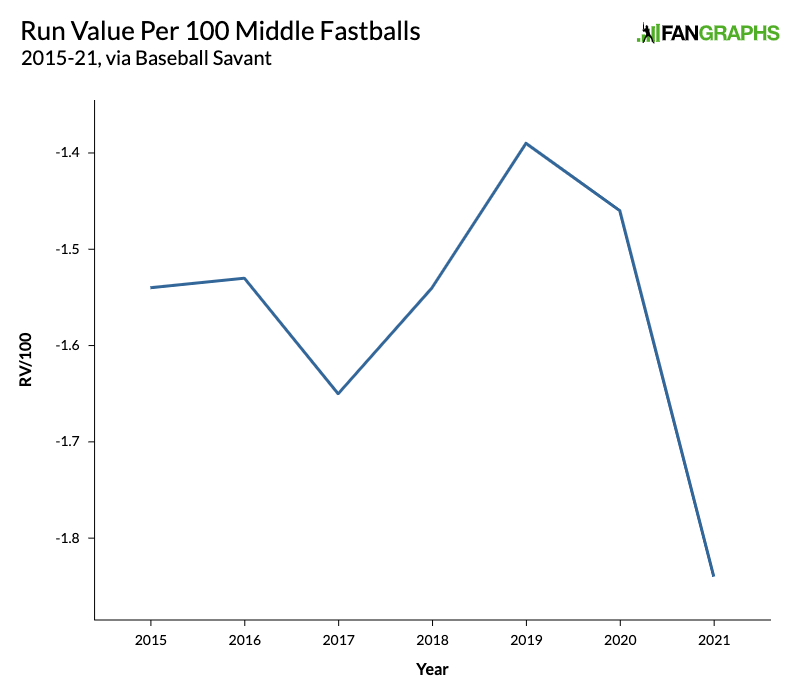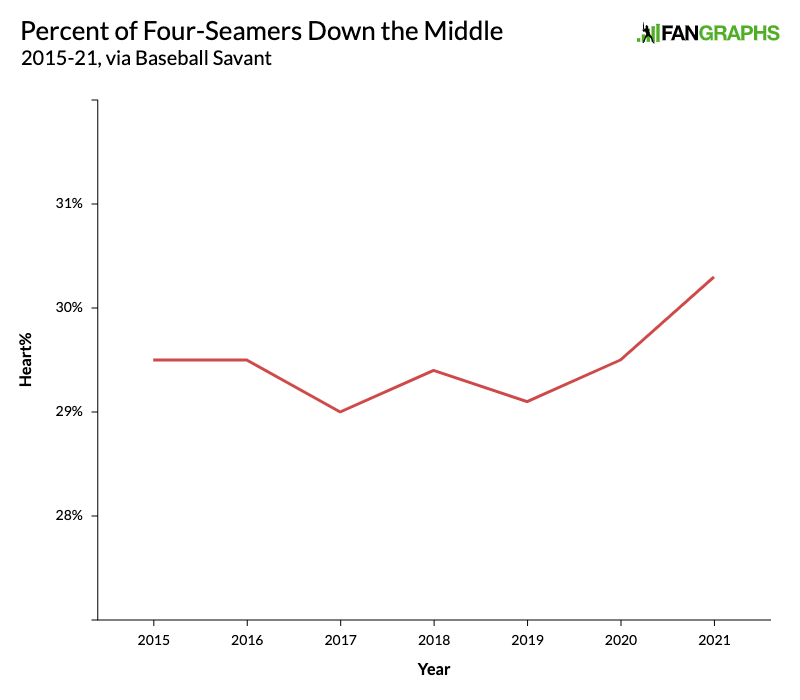Just Throw It Down the Middle
Is throwing a four-seam fastball down the middle a good idea? Regardless of whom you ask, the answer is probably no, and for good reason – the heart of the zone is where the majority of hard contact occurs, and fastballs are the most contact-prone of any pitch type. This disdain is rooted in our baseball lexicon, too. You’ll notice that after a ball is hit out of the park, broadcasters tend to remark that the pitcher “left one over the middle” or “hung his fastball.” The location is often to blame.
That doesn’t stop pitchers from trying, though. That’s not always because they want to – command comes and goes, after all – but it’s also because hitting a baseball is extremely difficult. Swings and misses happen! Bad contact happens! In each season since 2015, when Statcast data became public, hitters have accumulated a negative run value against down-the-middle fastballs. They’re still in the red despite seeing easier pitches. Though no pitcher would want to live solely in the middle, it makes sense why one might venture there.
But 2021 brought changes to the majors, and this is one of them: Hitters did worse against so-called meatballs than ever before. Here’s a graph that shows the league’s run value per 100 against fastballs in Baseball Savant’s “Heart” zone. Again, 2015 is the starting point:

You can see the year-to-year fluctuations right until the sudden drop-off in 2021. It’s jarring, given that league-wide numbers usually don’t experience notable changes. Is this because pitchers are throwing fewer fastballs down the middle? It’s true that pitchers aren’t as fastball-reliant as before, but no – the opposite is happening, in fact. This next graph indicates what percent of all four-seamers were located in the “Heart” each season:

To summarize, hitters were worse off against poorly located fastballs than ever before, in a season where they saw a greater rate of them than ever before. That’s confusing, and it wouldn’t be a FanGraphs article without numerous words, tables, and charts to infer why.
One reason: Fastballs are also faster than ever before. The velocity surge, once viewed with dismay and wonder, had largely plateaued since around 2016, when fastballs averaged 93.2 mph. That average rose to just 93.4 mph by 2020, the sluggish pace suggesting a limit to what humans could achieve. But pitchers broke out of their slump last season, recording an average fastball velocity of 93.7 mph. In conjunction with a new baseball, the sudden jump could explain hitters’ struggles against even the plainest fastballs, location-wise.
There seems to be more, though. The explosion in fastball velocity suggests a sudden improvement in results – fluctuating years preceded by a definitive jump. But look at fastballs located in the “Shadow” of the zone, and the decline in run value is gradual. It’s likely that over time, as more and more pitchers started climbing the ladder, hitters became increasingly ill-equipped to handle these fastballs. Last season represented a new low for borderline fastballs, sure, but merely in the footsteps of several lows before it. So how are pitchers’ strategies different with down-the-middle fastballs? How did they become, all of a sudden, better?
If there are any pitchers who might want to throw more surefire strikes, it’s those armed with plus fastballs. That sounds incredibly obvious when written out, but getting pitchers to trust their stuff is a relatively new coaching philosophy. I’m reminded of this article on the Rays’ success with developing pitchers, a process that once involved lefty reliever Cody Reed:
“They were like, ‘Hey man, your stuff is this good. Just throw it over the plate,’” Reed recalled. “And that was probably about as easy as any advice I’ve ever gotten. I was like, ‘Well, I can throw it over the plate for sure.’”
Reed didn’t quite pan out, but maybe there’s something here. As a test, I queried pitchers who threw at least 500 four-seam fastballs in both 2019 and ’21 – I opted to ignore the 2020 season due to its abbreviated length – and looked at who increased their rate of down-the-middle fastballs the most. Among the 93 pitchers included, here’s the top five in that category:
| Pitcher | 2019 Heart% | 2021 Heart% | Change |
|---|---|---|---|
| Kevin Gausman | 30.5 | 39.1 | 8.6 |
| Robbie Ray | 26.5 | 34.5 | 8.0 |
| Michael Wacha | 28.6 | 36.3 | 7.7 |
| Dylan Cease | 20.0 | 27.5 | 7.5 |
| Julio Urías | 26.9 | 34.1 | 7.2 |
Each pitcher listed here has a fastball that’s either (a) excellent on its own, or (b) solid, but pairs well with another part of his repertoire. Kevin Gausman is an example of the latter. His heater generates good but not great amounts of ride, and it’s about league-average in terms of velocity, but he can afford to pound the zone often thanks to his wicked splitter. We all know how Robbie Ray finally listened to the cries of many fans – throw more strikes! – and struck out just as many batters as before while drastically cutting his walk rate.
As for the remaining three pitchers, Michael Wacha finished the 2021 season with an ERA north of five, but he actually added two inches of ride to his fastball with the Rays; in addition, he phased out his cutter towards the tail end of last season and replaced those pitches with fastballs. Dylan Cease, meanwhile, has added a whopping five inches of ride since his rookie season to go along with his blazing speed. Lastly, Julio Urías took an already great fastball and proceeded to chuck it down the middle a little more often. The result? Hitters still didn’t stand a chance, as evidenced by the .322 xwOBA the pitch allowed last season.
These pitchers share another eye-brow raising trait: With the exception of Wacha, they managed to unlock career-best seasons while bucking the established notions of where one should locate a fastball. But lest we fall victim to narratives, I want to present another table. It’s one thing to make a connection between breakout pitchers and down-the-middle fastballs, but it’s another to eliminate the middleman altogether. We want the latter, of course, to obtain the raw numbers and give them a spin. Here’s my attempt at that:
| Velo/Vmov | <14.5″ | 14.5-16.4″ | 16.4-18.2″ | 18.2″+ |
|---|---|---|---|---|
| 95.4+ | -0.37 | -1.89 | -2.79 | -4.38 |
| 93.8-95.4 | -0.53 | -2.06 | -1.37 | -3.57 |
| 92.2-93.8 | -0.46 | -1.44 | -1.53 | -3.01 |
| <92.2 | -0.46 | -0.88 | -2.11 | -2.29 |
There’s a lot going on, but the idea is simple. Basically, I sorted every down-the-middle fastball from 2021 into groupings of velocity and vertical movement, then calculated the run value per 100 pitches in each group. The immediate takeaway is also straightforward. In the left-most column, which contains fastballs with below-average ride, you’ll see that an increase in velocity doesn’t seem to make a difference. In fact, regardless of velocity, these pitches all pale in comparison to fastballs with even an average amount of ride. How about the right-most column, reserved for fastballs with elite ride? It’s there that the effect of added velocity becomes apparent. But more importantly, consider how the slowest fastballs outperformed the fastest ones in the first column by a margin of nearly two runs per 100 pitches. Movement is king.
So yes, an uptick in league-wide fastball velocity helped, but overall, it seems like teams have realized that high-rise four-seamers greatly increase pitchers’ margins for error. They can afford to miss a spot; even if a fastball ends up in the heart of the zone, the odds of leaving unscathed are in their favor. If anything, asking a pitcher who struggles with command to nibble around the edges is counterproductive when his fastball has plenty of life. Teams have become increasingly good at addressing issues with fastball shape. Pitchers have become increasingly receptive to data-driven feedback. Those two factors, in a season that will be remembered for its countless no-hitters, best account for why hitters, as usual, pulled the trigger against incoming meatballs… and came up emptier than in years past.
Is throwing a four-seam fastball down the middle of a good idea? It’s tempting to blurt yes, but in general, the answer is still no. But if you’re a pitcher whose fastball has genuinely great stuff, sure! Go for it. Just launch that back-spinning, perfectly efficient beast of a heater down broadway. Who knows – you might pick up a Cy Young award and a nine-figure deal along the way:
Justin is an undergraduate student at Washington University in St. Louis studying statistics and writing.

I think was late career Bartolo’s strategy.
It’s hard to hit a baseball, throw strikes.
His nickname should have been “The Round Mound on the Mound.”
The plump schlump on a hump?
I would nickname him “He is better than you!”
I watched the late Bart version throw 100% fastballs over seven shoutout against Boston in Fenway, in terrible weather. Ski masks were out on the field. Catch it and throw it day for Bart.